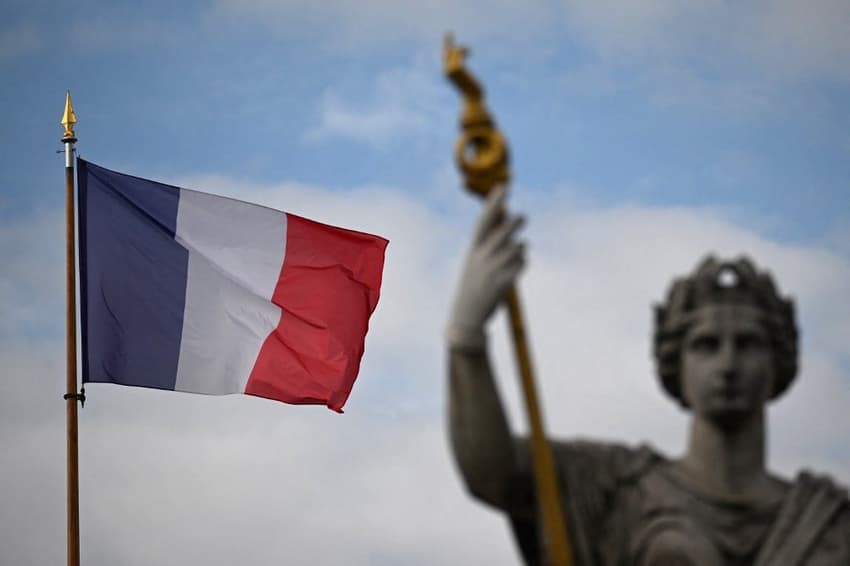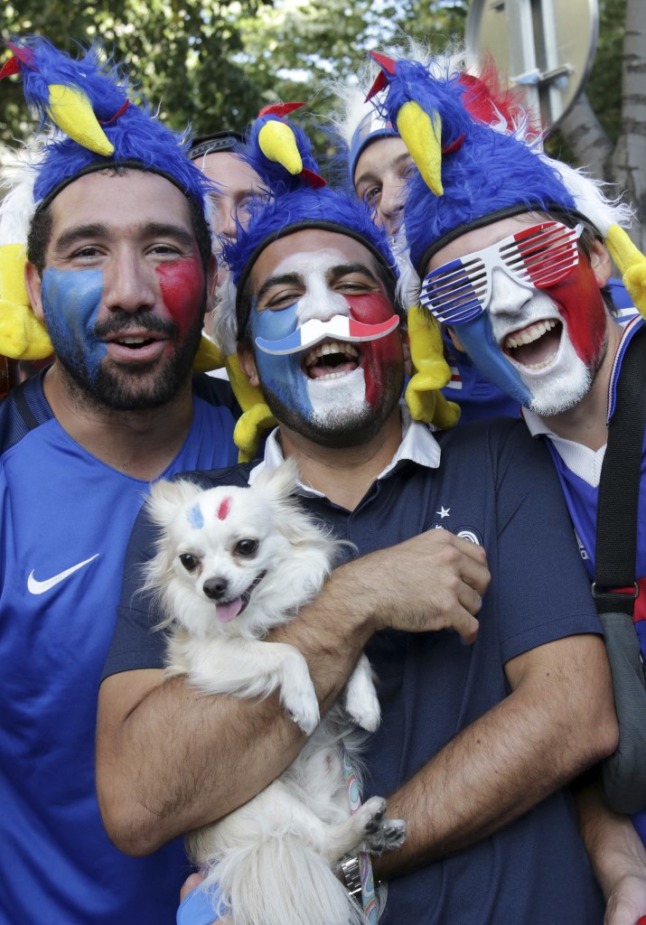Tricolore: 5 things to know about the French flag

One of the world's most recognisable flags, the French blue, white and red tricolore has a complicated history and a sometimes turbulent present.
1 You'll see it a lot
The French like their flag and they don't care who knows it. The tricolore flies from all French government buildings, this includes government ministries and the parliament, but also all public buildings such as local government offices, mairies and all schools.
It will be in the background of all formal announcements by ministers and government officials as well as at less formal occasions such as sports matches. With a simple design it also lends itself well to face-painting for sports fans.
French sports fans like to drape themselves in the flag and you'll also see it a lot on demos or protests as people carry the flag to underline their political points.
2 It's rarely alone
While the French flag is widely displayed, on most official buildings it is accompanied by the EU flag. The same is true for official announcements, formal staged press conferences and TV briefings. Invariably both the tricolore and the EU flag will hang in the background.
In 2023 the French parliament voted in favour of making it compulsory for local mairies to fly the EU flag alongside the French flag - to the surprise of many who thought that was already the case.
On special occasions the French flag and EU flag can be joined by a third flag on official buildings such as town halls. For example, the rainbow-striped LGBTQI flag is widely flown around France during Pride month and some mairies also fly the flag of Ukraine as a mark of solidarity.
On public holidays, official buildings add extra, smaller tricolore flags alongside the usual French and EU flags, just to add a sense of festivity, while in some towns buses and trams carry flags on public holidays.
On November 11th and May 8th (public holidays to mark Armistice Day and VE Day) extra flags are added to war memorials around the country.
3 It's revolutionary
The flag as we know it today comes from the French Revolution and the current design - blue next to the flagpole, white in the middle and then red - was formally adopted on February 15th 1794.
That means that the flag has a birthday which politicians like to celebrate.
Bon anniversaire à notre drapeau 🇫🇷, né le 15 février 1794 ! Ne le laissons pas être confisqué par les tenants d’un pays replié, d’une identité rétrécie. Soyons fiers et confiants ! pic.twitter.com/7nO6Sevrv1
— Clement Beaune (@CBeaune) February 15, 2022
The blue and red colours came from the cockades worn by the revolutionaries who stormed the Bastille while the white was the colour of the French monarchy - having the three together was originally intended to signify unity.
The French tricolore has not had an uninterrupted journey though. The complicated post-Revolutionary history of France, which saw it alternate between republic, monarchy, republic, dictatorship etc. meant that the tricolore was removed from circulation several times because it was too closely associated with the Revolution.
4 Its blue is changeable
Changes to the French flag are not only a historical phenomenon, however, the exact shade of blue used in the flag has changed twice in modern times.
The blue was originally bleu marine (navy blue) but in 1976 then-president Valéry Giscard d'Estaing switched to a brighter blue to match the colour of the EU flag - yellow stars on a blue background.
But in 2018 president Emmanuel Macron signed off on an initiative to change the colour back to its original navy.
The colour “evokes the memory” of the heroes who fought in the French Revolution, the trenches of World War I and in the Resistance during World War II, according to one Elysée official.
It was also suggested that the bleu marine is “more elegant”.
Since 2018 the Elysée has been using the darker flag - although it took until 2021 for anyone to notice - but other public buildings have retained their brighter blue flag.
5 It once featured the French coq
An early iteration of the flag featured the Gallic rooster. During the restoration of the monarchy, king Louis-Philippe introduced a version of the tricolore, surmounting it with the coq français.
This proved short-lived (as did the attempt to bring back the monarchy).
Today the French cockerel has no official status as a symbol of France, but is widely used including on the jerseys of French national sports teams, in bar and restaurant signs and on the heads of French sports fans.

French fans sporting Gallic rooster hats. Photo by JEAN CHRISTOPHE MAGNENET / AFP
Comments (1)
See Also
1 You'll see it a lot
The French like their flag and they don't care who knows it. The tricolore flies from all French government buildings, this includes government ministries and the parliament, but also all public buildings such as local government offices, mairies and all schools.
It will be in the background of all formal announcements by ministers and government officials as well as at less formal occasions such as sports matches. With a simple design it also lends itself well to face-painting for sports fans.
French sports fans like to drape themselves in the flag and you'll also see it a lot on demos or protests as people carry the flag to underline their political points.
2 It's rarely alone
While the French flag is widely displayed, on most official buildings it is accompanied by the EU flag. The same is true for official announcements, formal staged press conferences and TV briefings. Invariably both the tricolore and the EU flag will hang in the background.
In 2023 the French parliament voted in favour of making it compulsory for local mairies to fly the EU flag alongside the French flag - to the surprise of many who thought that was already the case.
On special occasions the French flag and EU flag can be joined by a third flag on official buildings such as town halls. For example, the rainbow-striped LGBTQI flag is widely flown around France during Pride month and some mairies also fly the flag of Ukraine as a mark of solidarity.
On public holidays, official buildings add extra, smaller tricolore flags alongside the usual French and EU flags, just to add a sense of festivity, while in some towns buses and trams carry flags on public holidays.
On November 11th and May 8th (public holidays to mark Armistice Day and VE Day) extra flags are added to war memorials around the country.
3 It's revolutionary
The flag as we know it today comes from the French Revolution and the current design - blue next to the flagpole, white in the middle and then red - was formally adopted on February 15th 1794.
That means that the flag has a birthday which politicians like to celebrate.
Bon anniversaire à notre drapeau 🇫🇷, né le 15 février 1794 ! Ne le laissons pas être confisqué par les tenants d’un pays replié, d’une identité rétrécie. Soyons fiers et confiants ! pic.twitter.com/7nO6Sevrv1
— Clement Beaune (@CBeaune) February 15, 2022
The blue and red colours came from the cockades worn by the revolutionaries who stormed the Bastille while the white was the colour of the French monarchy - having the three together was originally intended to signify unity.
The French tricolore has not had an uninterrupted journey though. The complicated post-Revolutionary history of France, which saw it alternate between republic, monarchy, republic, dictatorship etc. meant that the tricolore was removed from circulation several times because it was too closely associated with the Revolution.
4 Its blue is changeable
Changes to the French flag are not only a historical phenomenon, however, the exact shade of blue used in the flag has changed twice in modern times.
The blue was originally bleu marine (navy blue) but in 1976 then-president Valéry Giscard d'Estaing switched to a brighter blue to match the colour of the EU flag - yellow stars on a blue background.
But in 2018 president Emmanuel Macron signed off on an initiative to change the colour back to its original navy.
The colour “evokes the memory” of the heroes who fought in the French Revolution, the trenches of World War I and in the Resistance during World War II, according to one Elysée official.
It was also suggested that the bleu marine is “more elegant”.
Since 2018 the Elysée has been using the darker flag - although it took until 2021 for anyone to notice - but other public buildings have retained their brighter blue flag.
5 It once featured the French coq
An early iteration of the flag featured the Gallic rooster. During the restoration of the monarchy, king Louis-Philippe introduced a version of the tricolore, surmounting it with the coq français.
This proved short-lived (as did the attempt to bring back the monarchy).
Today the French cockerel has no official status as a symbol of France, but is widely used including on the jerseys of French national sports teams, in bar and restaurant signs and on the heads of French sports fans.

Join the conversation in our comments section below. Share your own views and experience and if you have a question or suggestion for our journalists then email us at [email protected].
Please keep comments civil, constructive and on topic – and make sure to read our terms of use before getting involved.
Please log in here to leave a comment.